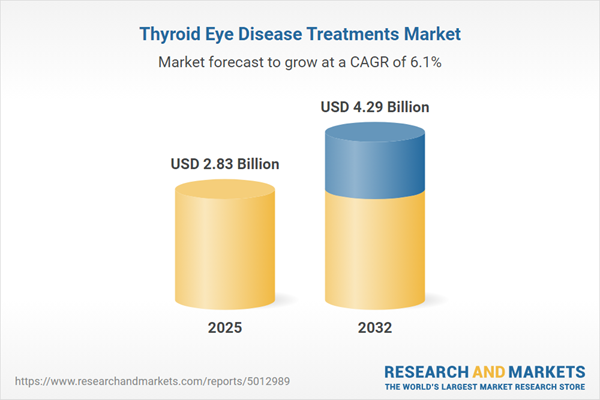Speak directly to the analyst to clarify any post sales queries you may have.
The thyroid eye disease treatments market is undergoing substantial transformation, fueled by new therapies, advanced diagnostics, and evolving care pathways. As a complex autoimmune disorder, thyroid eye disease challenges health systems and presents significant opportunities for innovation and patient-centered solutions.
Market Snapshot: Thyroid Eye Disease Treatments Market
The global thyroid eye disease treatments market grew from USD 2.67 billion in 2024 to USD 2.83 billion in 2025. It is forecast to sustain a compound annual growth rate (CAGR) of 6.09%, reaching USD 4.29 billion by 2032. This growth is driven by increasing disease prevalence, expanding therapeutic options, and heightened clinical attention to patient quality of life and healthcare utilization.
Scope & Segmentation
This report delivers a thorough analysis of the thyroid eye disease treatments market across key segments and regions, highlighting both established and emerging technologies.
- Treatment Type: Medical therapy (corticosteroids, immunosuppressants, monoclonal antibodies, thyroid hormone control, tyrosine kinase inhibitors); Surgical interventions (eyelid surgery, orbital decompression surgery, strabismus surgery)
- Route of Administration: Intravenous, oral, and topical therapies
- Disease Type: Type I TED and Type II TED
- Diagnosis: Blood tests, imaging tests, orbital ultrasound, radioactive iodine uptake test
- End-User: Hospitals, outpatient centers, specialty clinics
- Distribution Channel: Offline and online retail
- Regional Analysis: Coverage includes the Americas (United States, Canada, Mexico, Brazil, Argentina, Chile, Colombia, Peru), Europe, Middle East & Africa (United Kingdom, Germany, France, Russia, Italy, Spain, Netherlands, Sweden, Poland, Switzerland, United Arab Emirates, Saudi Arabia, Qatar, Turkey, Israel, South Africa, Nigeria, Egypt, Kenya), and Asia-Pacific (China, India, Japan, Australia, South Korea, Indonesia, Thailand, Malaysia, Singapore, Taiwan)
- Key Companies: Abbott Laboratories, Amgen Inc., AbbVie Inc., ACELYRIN, INC., argenx SE, Bausch & Lomb Incorporated, BioXpress Therapeutics SA, Cipla Limited, Dr. Reddy's Laboratories Ltd., Eli Lilly and Company, F. Hoffmann-La Roche AG, Genmab A/S, GlaxoSmithKline PLC, H. Lundbeck A/S, Hetero Drugs Limited, Immunovant, Inc., Intas Pharmaceuticals Ltd., Johnson & Johnson Services Inc., Lupin Limited, Merck KGaA, Novartis AG, Pfizer, Inc., Regeneron Pharmaceuticals, Inc., Sling Therapeutics, Inc., Teva Pharmaceutical Industries Ltd., Viridian Therapeutics, Inc.
Key Takeaways for Senior Decision-Makers
- Targeted biologic therapies are advancing precision immunomodulation, increasingly preferred over broad immunosuppression due to enhanced efficacy and safety.
- Clinical management is shifting toward individualized care pathways, supported by improved diagnostics and biomarker-driven patient stratification.
- Collaborative, multidisciplinary treatment models integrate endocrinologists, ophthalmologists, and surgeons, aiming toward comprehensive and seamless care delivery.
- Innovation in both medical and surgical interventions is enabling more personalized, outcome-oriented approaches across care settings.
- Investment in digital health, real-world evidence generation, and sustained-release drug delivery platforms is shaping industry competition and patient engagement.
- Strategic alliances with academic centers and technology innovators are critical, accelerating the development of next-generation therapies while informing regulatory and payer strategies.
Assessing Tariff Impact on Supply Chain Stability and Affordability
Recent tariff measures in the United States have affected import costs for key pharmaceutical ingredients and surgical equipment, prompting manufacturers to reevaluate pricing and procurement. Some organizations have responded by advancing nearshore production, renegotiating contracts, and engaging industry consortia to advocate for tariff exemptions. These adaptations aim to safeguard patient access and supply reliability in an evolving policy environment.
Research Methodology & Data Sources
Our research employs a multi-tiered approach, combining primary interviews with clinical leaders and industry stakeholders with systematic secondary review of academic literature, clinical trial data, and regulatory filings. This enables triangulation and validation of trends and delivers actionable, science-based insights tailored to market realities.
Why This Report Matters
- Equips senior decision-makers with a detailed, segment-level understanding of the evolving thyroid eye disease treatments market to inform resource allocation and strategic planning.
- Offers clarity on regional opportunities and risks, supporting tailored market entry and expansion strategies in diverse healthcare economies.
- Provides actionable intelligence on trends, innovation, and competitive positioning, ensuring relevance in a dynamic therapeutic landscape.
Conclusion
The thyroid eye disease treatments market is reshaping through clinical advances, patient-centric strategies, and robust collaboration across sectors. This report delivers the insights necessary to navigate ongoing changes and capture new value in a complex, growing field.
Additional Product Information:
- Purchase of this report includes 1 year online access with quarterly updates.
- This report can be updated on request. Please contact our Customer Experience team using the Ask a Question widget on our website.
Table of Contents
3. Executive Summary
4. Market Overview
7. Cumulative Impact of Artificial Intelligence 2025
Companies Mentioned
The companies profiled in this Thyroid Eye Disease Treatments market report include:- Abbott Laboratories
- Amgen Inc.
- AbbVie Inc.
- ACELYRIN, INC.
- argenx SE
- Bausch & Lomb Incorporated
- BioXpress Therapeutics SA
- Cipla Limited
- Dr. Reddy’s Laboratories Ltd.
- Eli Lilly and Company
- F. Hoffmann-La Roche AG
- Genmab A/S
- GlaxoSmithKline PLC
- H. Lundbeck A/S
- Hetero Drugs Limited
- Immunovant, Inc.
- Intas Pharmaceuticals Ltd.
- Johnson & Johnson Services Inc.
- Lupin Limited
- Merck KGaA
- Novartis AG
- Pfizer, Inc.
- Regeneron Pharmaceuticals, Inc.
- Sling Therapeutics, Inc.
- Teva Pharmaceutical Industries Ltd.
- Viridian Therapeutics, Inc.
Table Information
| Report Attribute | Details |
|---|---|
| No. of Pages | 186 |
| Published | November 2025 |
| Forecast Period | 2025 - 2032 |
| Estimated Market Value ( USD | $ 2.83 Billion |
| Forecasted Market Value ( USD | $ 4.29 Billion |
| Compound Annual Growth Rate | 6.0% |
| Regions Covered | Global |
| No. of Companies Mentioned | 27 |









